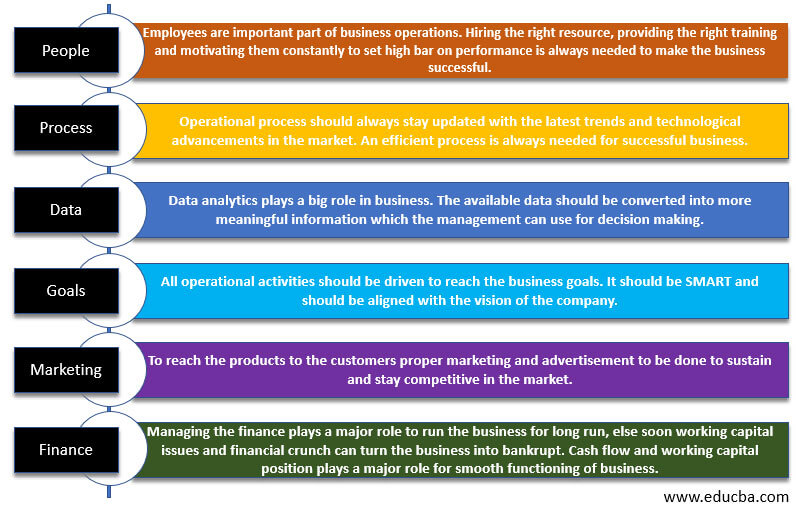Updated July 13, 2023

What is Business Operation?
Business operation refers to the day-to-day activities of any business, which could be anything that generates revenue for the business. The purpose of business operations is to perform activities that create revenue and make the business profitable. (E.g.) Manufacturing, services, etc.
Business Operations are revenue-generating activities aligned with the business goals and objectives. The activities lead to covering up the expenses incurred and leading to profits. It can increase business assets, secure the income to be generated from any asset, or increase the value of the business.
The business operations constantly evolve as the business grows and expands. Considering the nature and size of the business, the operational activities keep varying.
Examples of Business Operation
Business operations vary according to the nature of the business. For Example, in the case of a retail business, the following would be the key business operations.
ABC Corp is a retail clothing store; the company’s operational activities start from procuring apparel from different manufacturers considering multiple brands, sizes, quality, customer choices, etc. Once they procure the apparel next step comes to the physical outlet and the staff operations.
The store/outlet will store the goods and appoint requisite staff to manage it while actively attracting customers as part of advertising/market promotion.
Types of Business Operations
The business operations can be classified based on the nature of the business and industry. The following are the major types of business operations.
1. Manufacturing Business
Manufacturing business operations majorly involve converting raw materials into physical products sold to customers. Major operational activities involve the production process, achieving efficiency, and procuring the right quality of raw materials from vendors. Stocking raw materials also play a major role, as inputs should be readily available to produce the goods. Post-production logistics is also key in sending the goods to the customers.
(E.g.) A toy manufacturer would need raw materials like plastic, casts, etc., to produce and sell the finished product as toys.
2. Retail Business
The major operation of the retail business is to procure products from manufacturers with more customer demand and sell the products at the price customers are willing to pay and make a profit. As the major activity of the business model is external procurement, inventory management is one of the important functions in the retail business. (e.g.) Clothing stores, grocery stores, hardware stores, etc., come under the retail category.
For a better retail business operation, goods should procure depending on the customer’s needs and expectations, and also, there should be the right demand in the market. The next comes the payment terms offered, which could attract more customers if it is better than competitors. (E.g.) For bulk purchases, 5% discount or 30 days credit.
3. Service Business
A service business refers to providing services to customers which are intangible. The business offers many services to customers, like Professional advice from experts like lawyers, accountants, etc. We provide cleaning services, training centers, banks, maintenance or repair services, movie theatres, banks, etc.
Service usually deals with manpower support, and business operations predominantly involve recruiting the right staff based on the nature of the business. They are usually the core employees of the business as they provide the services, so they should be trained well. There will also be another set of activities which will be customer-facing employees and activities where market promotion, the customer connects and improves customer satisfaction.
Pillers of Business Operation
How to Enhance Business Operation?
1. Performance Metrics: Business operations should be carried out with the goals and objectives of the business. Constant performance evaluation against goals and mitigation of gaps should occur by devising alternative plans and implementing additional measures. Regular intervals of metric performance evaluation are necessary to ensure the business is on the right track.E.g., Growth in Revenue for the year by 20%. This goal should be constantly evaluated with the M-o-M performance.
2. Stay updated with the Market: For a business to run better, it should stay updated with the latest trends in the market. The New laws and regulations concerning their business, new technology, new trends in operational models, etc., should be understood. The business operations should update accordingly to sustain in the market for the long run.
3. Process Improvements: To improve the business performance and operation, the process should be improved by adopting new technology, tools, machinery, advanced techniques, etc. Process improvements are much needed to stay competitive and improve the business’s operations and profitability.
Business Operation Analysis
Business operations analysis is a strategy formed to ensure that business operations are running smoothly and in the direction, it has to. Through this analysis, the system’s bottlenecks and challenges can be rectified so that nothing stops the business from reaching its goal. It is more of an evaluation and analysis of the process and operational structure to ensure everything is set in place. Also, it helps to highlight the areas of improvement, adopting new techniques, etc.
Conclusion
Business operations are daily business affairs involving many activities and processes and significantly vary from industry to industry. For any business to scale up and perform better, business operations play a prime role, and entrepreneurs should always work towards improving the efficiency of the process. A better operational process could always save costs and bring more profits. On top of everything, business operations should always be aligned with the business goals.
Recommended Articles
This is a guide to Business Operation. Here we also discuss the definitions and how to enhance Business operations along with the types and examples. You may also have a look at the following articles to learn more –

